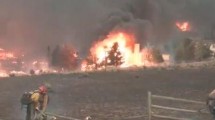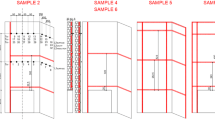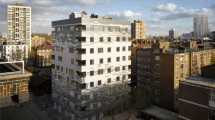Abstract
Roof assemblies are known to be vulnerable to firebrands in urban and wildland-urban interface fires. In the 2016 urban fire in Japan (Itoigawa-City Fire), at least 10 structures were ignited by firebrand showers and three of these structures were ignited by firebrand penetration under roof tiles. In this study, the vulnerabilities of Japanese-style roof tile assemblies to firebrand exposures were investigated by using a continuous-feed firebrand generator with applied nominal wind speeds of 6 m/s and 9 m/s. It was observed that Japanese-style roof tile assemblies were more vulnerable than concrete flat, concrete profile, and terracotta flat roof tiles for an applied wind speed of 6 m/s. When the experiments were performed with debris placed underneath the roof tiles, penetrated firebrands ignited debris. Flaming ignition was observed under 9 m/s where flame was observed to protrude from the tiles in an effort to reach necessary oxygen for combustion.














Similar content being viewed by others
References
Thomas D et al (2017) The costs and losses of wildfires. NIST Special Publication 1215. https://nvlpubs.nist.gov/nistpubs/SpecialPublications/NIST.SP.1215.pdf
Manzello SL, Foote EID (2014) Characterizing firebrand exposure from wildland–urban interface (WUI) fires: results from the 2007 Angora fire. Fire Technol 50:105–124. http://dx.doi.org/10.1007/s10694-012-0295-4
Maranghides A et al (2015) A case study of a community affected by the waldo fire—event timeline and defensive actions. NIST TN1910. https://doi.org/10.6028/nist.tn.1910
Suzuki S (2017) A review on structure ignitions by firebrands. Bull Jpn Assoc Fire Sci Eng. 67(1):49–55 (in Japanese)
National Research Institute of Fire and Disaster (2018) Report on Itoigawa fire. NRIFD technical report No. 84
Suzuki S, Manzello SL (2018) Characteristics of firebrands collected from actual urban fires. Fire Technol 54:1533–1546
ISO 12468-1:2013 External exposure of roofs to fire—part 1 test method
Manzello SL (2014) Enabling the investigation of structure vulnerabilities to wind- driven firebrand showers in wildland-urban interface (WUI) fires. Fire Saf Sci 11:83–96. http://dx.doi.org/10.3801/IAFSS.FSS.11-83
Manzello SL, Hayashi Y, Yoneki T, Yamamoto Y (2010) Quantifying the vulnerabilities of ceramic tile roofing assemblies to ignition during a firebrand attack. Fire Saf J 45:35–43
Manzello SL (2013) The performance of concrete tile and terracotta tile roofing assemblies exposed to wind-driven Firebrand showers. NIST technical note 1794. http://dx.doi.org/10.6028/NIST.TN.1794
Suzuki S, Manzello SL, Nii D (2017) The performance of wood and tile roofing assemblies exposed to continuous firebrand assault. Fire Mater 41:84–96. http://dx.doi.org/10.1002/fam.2372
Suzuki S, Manzello SL (2017) Experiments to prove the scientific-basis for laboratory standard test methods for firebrand exposure. Fire Saf J (Special issue on fire safety science—proceedings of 12th international symposium) 91:784–790
JIS A 5423:2013 Decorated cement shingles for dwelling roofs
Manzello SL, Suzuki S (2017) Generating wind driven firebrand showers characteristics of burning structures. Proc Combust Inst 36:3247–3252
Kawara Yane Hyojun Sekou Youryousho, JKY-2014. http://www.yane.or.jp/manual/53a/pdf_53a.pdf. Accessed 16 Apr 2020
SL Manzello, TG Cleary, JR Shields, JC Yang (2006) Ignition of mulch and grasses by firebrands in wildland–urban interface fires. Int J Wildland Fire, 15(3):427–431
Manzello SL et al (2008) Experimental investigation of firebrands: generation and ignition of fuel beds. Fire Saf J 43(3)::226–233
Manzello SL et al (2006) On the ignition of fuel beds by firebrands. Fire Mater 30(1):77–87
Drysdale D (2011) An introduction to fire dynamics, 3rd edn. Wiley, London
Author information
Authors and Affiliations
Corresponding author
Additional information
Publisher's Note
Springer Nature remains neutral with regard to jurisdictional claims in published maps and institutional affiliations.
Rights and permissions
About this article
Cite this article
Suzuki, S., Manzello, S.L. Experimental Study on Vulnerabilities of Japanese-Style Tile Roof Assemblies to Firebrand Exposures. Fire Technol 56, 2315–2330 (2020). https://doi.org/10.1007/s10694-020-00982-2
Received:
Accepted:
Published:
Issue Date:
DOI: https://doi.org/10.1007/s10694-020-00982-2




